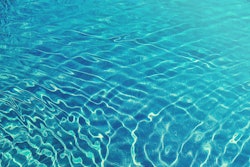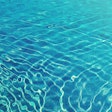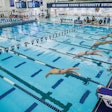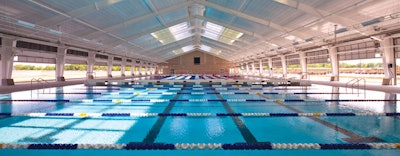
When a local school district first expressed interest in passive-ventilation options for its new aquatics facility, some of the architects involved in the project were understandably skeptical. How would this work with a natatorium?
"It's is a large volume of space — a giant water bowl — stirred with chlorine and then heated to 84 degrees," says Nicola Springer, vice president and head of the K-12 team at Houston-based architecture firm Kirksey. "There are a complex set of problems — humidity, odor and lack of fresh air."
Could passive ventilation adequately address those important issues?
Aquatic facilities are among the most expensive of recreational facilities to construct, maintain and operate. But stripping away unnecessary features can serve to strip away the financial constraints that make aquatic facilities unachievable for some communities. Traditionally, a natatorium's HVAC system hasn't been considered an unnecessary feature, but with a potential $800,000 savings on the line, the architectural team at Kirksey decided it was worth investigating.
The case for passive ventilation hinges on a particular quirk of an aquatic facility that works in its favor. The majority of the people in a natatorium wear far less clothing than in a typical indoor environment. Applying the thermal comfort expectations of office workers to swimmers not only makes building users uncomfortable, but squanders an opportunity to put money back in the owner's pocket.
The thermal comfort conditions typically controlled through an HVAC system are air temperature and relative humidity. However, other parameters that are equally important but often overlooked include a person's activity level, their amount of clothing, the movement of the surrounding air and radiant temperature of surrounding objects.
After studying the thermal comfort factors noted above, the Kirksey team identified optimum comfort level for swimmers and determined how many hours of the year this comfort level could be achieved naturally through optimizing air flow, evaporative cooling and minimal heating — all of which greatly reduce a building's required mechanical equipment. When considering the design this way, airflow simulations became the primary driver of the natatorium's shape. The location of openings and proximity to surrounding buildings were critical determinants of the amount of airflow within the building.
The team determined that not only was a thermally comfortable indoor environment achievable through passive design, but indoor air quality would actually be improved as greater volumes of outside air moved through the space, sweeping away odors and chemical pollutants from the pool surface. Here's a look at how the firm used the design strategy successfully in two different projects.
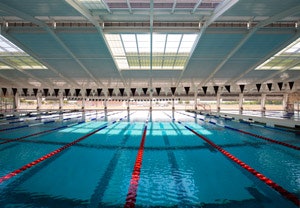 AERIAL ENGINEERING In designing the aquatic facility for Fort Bend ISD, scientific modeling was used to maximize impact of airflow. — Click here to see more
AERIAL ENGINEERING In designing the aquatic facility for Fort Bend ISD, scientific modeling was used to maximize impact of airflow. — Click here to see more
FORT BEND ISD AQUATIC PRACTICE FACILITY
Houston has nine months of warm weather and three months of cool weather, making it a perfect setting to test out a passive-ventilation pool design for the Fort Bend Independent School District.
Through a detailed thermal comfort analysis, the Kirksey team determined that 33 percent of 3,651 annual occupied hours would be naturally comfortable for a swimmer in Houston with the use of different passive environmental strategies. Taking into account evaporative cooling from the pool and the addition of a heating system for cold months, the percentage of comfortable hours could be increased to 77 percent, according to ASHRAE 55-2010 comfort models. This would leave about 23 percent of annual hours during which air conditioning would be needed, and most of the "unmet" hours would fall during summer afternoons when temperatures would be so high that no feasible alternative outside of an active system could ensure comfortable conditions.
Passive ventilation essentially works in two ways: cross ventilation, which moves fresh air across an open area, and stack ventilation, wherein hot air rises and is displaced by cooler air. In hot, humid climates, cross ventilation must be used during summer and stack ventilation during winter.
To facilitate natural ventilation in summer by increasing cross ventilation, airflow simulations were done using computational fluid dynamics. Kirksey experimented with different design options intended to take advantage of the Venturi Effect, a phenomenon describing the increase in air speed when it moves through a smaller opening. The final design maximized open areas on both windward and leeward sides, which increased air velocities. In addition, operable skylights in the roof were utilized to further increase airflow velocities, which, when combined with the other factors of thermal comfort, suggested that there would be enough airflow to create comfortable conditions.
The resulting pool enclosure functions like an open-air pavilion. A pre-engineered steel structure is clad on the roof with semi-translucent operable skylights for controlled air movement and light transmittance.
Natural ventilation at the FBISD pool has turned into a great success. FBISD not only saw the first-cost savings of foregoing an air-conditioning system (an estimated $800,000 credit), but also benefits from reduced annual energy consumption, minimal maintenance and other reduced operating costs. The facility incurs roughly half of the annual operating costs of a similarly sized conventional natatorium in Houston — about $101,300 compared to $204,900.
This energy saving was achieved without compromising the indoor air quality in the facility. While carbon dioxide levels of 800 to 900 parts per million are common in conditioned pools, the FBISD aquatic practice facility measured less than 450 ppm. The fresh air coming into the space also removes the chemicals off-gassed from pool waters, which can cause stinging eyes and respiratory irritation.
The passive design gives occupants greater control over their thermal conditions, allowing users to regulate air speeds by modulating the number and height of door openings when outdoor air temperatures are warm. A survey of facility staff showed that increased air speeds also helped in drying the pool deck, and that radiant heaters are sufficient for heating during winters. The most telling success of the facility comes from the fact that although it was intended for use as a practice facility, the FBISD Aquatic Practice Facility has become a favorite spot for holding district competitions.
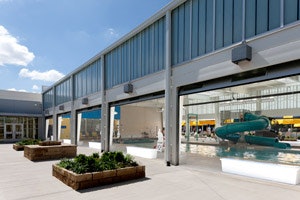 CURRENT CONCERNS The different climate conditions at Euless Aquatic Center created a challenge when determining how to effectively move moist air when the doors were closed. — Click here to see more
CURRENT CONCERNS The different climate conditions at Euless Aquatic Center created a challenge when determining how to effectively move moist air when the doors were closed. — Click here to see more
CITY OF EULESS AQUATIC CENTER
Kirksey's second passively ventilated natatorium, the City of Euless Aquatic Center, presented a different set of challenges. While Fort Bend's space was designed primarily for youths, the Euless facility caters to an older population, including many users over 50, with distinct thermal comfort considerations, including different metabolic rates and activity levels. The intended site offered very little opportunity for air movement. Multiple design iterations revealed that to optimize cross ventilation, the natatorium had to be exactly 20 feet from an existing building. This distance created a perfect stack to draw air from the leeward side and channel it up and through the natatorium.
Colder than Houston, the Dallas-area climate where Euless is located requires heating during a significant part of the year. This introduced an additional concern: being able to sufficiently ventilate moist air through the stack effect when the doors were closed during winter. Airflow simulations helped determine the location of exhaust louvers on the roof in order to accomplish this.
Senior citizens have lower metabolic rates, so special care was also needed to address their thermal comfort during winter. Concrete floors, which can both conduct and radiate cold onto bare feet, can be uncomfortable, sparking the decision to include radiant floor heating in the pool deck to maintain a consistent slab temperature at 80 degrees.
The final solution is an elegant, efficient structure using a pre-engineered metal frame and establishing a courtyard that serves as both an amenity and a source of airflow.
As with the Fort Bend ISD facility, Kirksey performed a post-occupancy evaluation, which revealed that users were happy overall with the building. Almost all occupants noted satisfaction with lighting, temperatures, air movement and air quality. Carbon dioxide measurements are a good gauge to determine if ventilation levels are adequate. Airflow data measured during summer with doors open showed carbon dioxide levels between 90 and 250 ppm on the leeward side of the pool, while levels were between 380 and 450 ppm on the windward side, indicating presence of 100 percent fresh air. A few occupants complained of thermal comfort problems when doors were kept closed during storms, and some lifeguards complained of thermal discomfort during winter. These observations point to one of the key conclusions of the post-occupancy evaluation, namely that some zonal air flow with fans and heating may be required to supplement comfort in passively ventilated facilities when doors must be kept closed.
Importantly, the cost savings from removing the HVAC system on this project allowed the city to construct an additional outdoor recreation area. The success of the design and the popularity of the facility have led to an extension of its operating schedule to include year-round use.
THE BOTTOM LINE
Passive design offers myriad benefits to aquatic facilities, from healthier environments with greater occupant satisfaction to significant cost savings for owners. Such facilities cannot be designed from templates, but instead require appropriate tools, careful analysis and design sensibilities. Each building and site has unique challenges and opportunities that should be addressed with more than conventional wisdom.
Kapil Upadhyaya, is a senior associate and building performance analyst with Houston-based Kirksey Architecture.
This article originally appeared in the October 2015 issue of Athletic Business with the title "Air Quality Control"


















